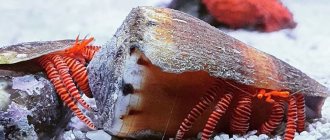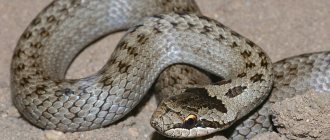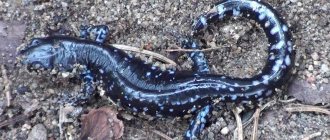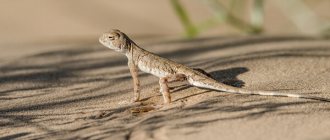If you find a very large brownish snail with a round shell and an elongated slimy body on a humus heap, grass or other damp places, then it will most likely be grape snail. For a long time I believed that such snails could only live in the warm south. But recently I saw them in the Tver region not far from the Ivankovo reservoir (Moscow Sea). Grape snails have also multiplied in Valdai. They are found in Moscow on the territory of the All-Russian Exhibition Center, the Timiryazev Academy and even in parks. Farms have appeared near Moscow where giant land-based mollusks are grown. Recently, there have been publications with such headlines as: “Grape snails are attacking the Moscow region,” “Grape snails are conquering the north,” “Let’s protect our gardens from grape snails.” Some people find this large mollusk so cute that they put it in a terrarium and keep it as a pet.
Grape snail
Description and features
The body of a mollusk consists of visible parts: a shell and a body, in which a head with tentacles and a leg are distinguished. A special mantle serves as protection for internal organs hidden in the shell. Some folds can be seen on the outside.
The diameter of the spiral-shaped shell is 3.5-5.5 cm. The rounded, swollen shape allows you to completely hide the body if necessary. The shell is twisted to the right with 4.5 turns. The lower circle serves as a wide base.
The color of the shell is predominantly yellow-brown, less often dark gray; some whorls have dark and light grooves. The saturation of the color scheme depends on the climatic factor and the diet of the mollusk. The variability of the cover is associated with the natural camouflage of snails.
The ribbed surface of the right-handed shell is noteworthy. Due to the structural features, the strength indicator increases and more moisture accumulates for life support.
The leg of an adult mollusk can stretch up to 9 cm, although in its normal state the length is from 3 to 5 cm. A soft body with increased elasticity. Thick wrinkles with quadrangular grooves between them effectively retain moisture.
The structure of the grape snail
A pair of tentacles on the snail's head are located above the mouth opening. The tentacles are very active, changing position to an angle greater than the unfolded one. High sensitivity is manifested in the reaction to light, the slightest touch - they instantly hide deep into the house.
The lower ones, labial, 2.5-4.5 mm long, are associated with the sense of smell. On the top are the organs of vision. The length of the eye pair of tentacles is 10-20 mm. The snail distinguishes the intensity of light, sees objects at a distance of up to 1 cm. The mollusk does not distinguish the color range.
Snail breathing is pulmonary. In the folds of the mantle there is a hole that seems to be closed on average once a minute. Respiration activity depends on carbon dioxide in the air and humidity levels.
An interesting feature of grape snails is the ability to restore lost body parts. Partial loss of head or tentacles is not fatal - the animal will grow them back in 2-4 weeks.
What is a mollusk shell?
The shell is an integral part of any snail. Thanks to the external skeleton, the latter can protect itself from attacks by natural enemies and from the influence of other natural factors from the outside. The sink also helps retain moisture.
The external skeleton resembles a cone. By the way, it is precisely because of this shape that the organs of the cochlea are located asymmetrically. The upper layer of the skeleton is usually smooth or has small growths.
Lifestyle and habitat
The spread of gastropods occurred throughout almost all of Europe. Valleys, lawns, edges, overgrown ravines, city parks, gardens are a comfortable habitat for these unpretentious creatures.
The active state of grape snails lasts from the first sunny days of spring until the autumn cold. Seasonal wakefulness of mollusks does not exceed 5 months. Moisture-loving animals are often found among stones, in the shade of bushes, and burrow into damp moss.
During the day, during dry times, they are motionless, hiding in places where moisture is better preserved. They sit in shells covered with a thin film to prevent evaporation. As if glued to trunks or branches, they wait out the midday heat. Heat, like cold, numbs snails.
Night time and damp weather awaken snails to search for food. The mollusk gets out of its hiding place and hits the road. The muscular leg carries the cochlea due to muscle contraction and secreted mucus, which softens friction.
The surface on which the mollusk crawls can be horizontal, vertical, or located at any angle. The grape snail pushes off from the support and glides at a speed of up to 7 cm per minute.
There are many natural enemies of the snail. It is a delicacy for all reptiles, hedgehogs, and moles. Some beetles crawl inside the mollusk through the breathing hole. With the arrival of autumn cold, the snail buries itself in the ground with its mouth raised for hibernation.
This arrangement protects against bacteria, retains a small layer of air, and allows you to quickly get out of the shelter in high water. The period of suspended animation lasts approximately 3 months. The animal digs a hole with its muscular leg. Depending on the density of the soil, the dug channel reaches 6 - 30 cm. If the rocky soil does not give way, the snail finds refuge under the autumn leaves.
The mollusk covers the mouth of the shell with a special mucous veil. After hardening, the lime layer becomes a reliable lid. The thickness of the cork varies, depending on the severity of the winter. Air enters through a small hole.
You can notice gas exchange by bubbles when the mollusk is immersed in water. Gastropods spend the wintering period alone, but sometimes gather in entire colonies. During wintering, the grape snail loses up to 10% of its weight.
In the spring, after awakening, the recovery period begins. Animal lovers are engaged in keeping and breeding shellfish. Although there are bans on their import into certain countries, interest in snails does not fade.
Behavior in nature
The activity of land snails is determined by several factors:
- temperature
- ambient humidity
- intensity of sunlight.
During daylight hours they hide and burrow into soft ground.
Giant snails in nature feed at dusk or at night, becoming active during the rainy season at temperatures of 10 - 29 degrees. During daylight hours, they hide and burrow into soft ground to escape the heat and predators. At low temperatures and low humidity, they hibernate, closing the entrance to the shell. These gastropods have adapted to living in temperate climates.
Grape snail breeding
The history of gastropod breeding is very ancient. Successful snail farms to this day supply shellfish as a commodity for domestic consumption and for export. Hobbyists can create their own clam at home.
In winter, equipment and pets should be kept warm, and in summer, snail farming can be done outside (in courtyards, dachas). The safety of defenseless gastropods depends on humans, so we must not forget about the threat of rodents and domestic animals.
Breeding grape snails as a business idea, since their meat is considered a delicacy
To keep snails you will need spacious glass or plastic containers with a volume of 200-250 liters with good ventilation. A container for young animals, separate enclosures for breeding, containers for sale will not be financially burdensome for a beginning entrepreneur.
Create comfortable conditions for residents
- large area of the bottom of the house;
- moistened soil with the addition of 1/6 part of activated carbon;
- plants, twigs, moss to imitate the natural environment;
- small pond;
- pieces of chalk for feeding - strengthens the shell;
- a lid with holes for the box - snails crawl out if there are no obstacles.
Breeding grape snails will be successful if the daytime temperature is maintained at 20-22°C, and the nighttime temperature is 2-3 degrees lower. Temperatures above or below normal cause the inhabitants to hibernate. To maintain the required humidity of 85-90%, you need to moisten glass and other surfaces twice a day with a household spray bottle.
Grape snails are used in cosmetology
Cleanliness must be maintained by wiping the walls of the box and removing mucus from the interior. Keeping and caring for a grape snail is not difficult, even for beginners.
Historical data
The habitat of Achatina is the equatorial part of East Africa. Not without human help they moved to Madagascar, Seychelles, India, and Sri Lanka. In Indochina, they spread throughout the entire territory in just 10 years.
Once in the United States, they managed to destroy most of Florida's farmland in a few months. Every effort was made to destroy them. Because of this, Achatina is prohibited from being brought into the United States and kept as pets. Violators of the ban face a five-year prison sentence and a huge fine.
India and Taiwan faced the same problems. Hindus destroy millions of snails every year. However, local residents of these countries began to eat them with pleasure, inventing various dishes. Achatina soup is popular in India as a healing remedy for lung diseases.
Nutrition
The name of the snail speaks of its favorite delicacy - grape leaves, although the herbivorous creature feeds on almost any vegetation, even grass and humus. At home, pets should be fed food that is as close as possible to what they consume in the wild. The diet includes
- nettle leaves;
- salad;
- wild strawberries;
- burdock;
- radish;
- lungwort;
- dandelion;
- cabbage;
- horseradish;
- plantain.
Greens should be fresh, juicy, clean. You can add chopped pieces of cucumber and zucchini to your food. At home, the grape snail readily feeds on hemp and flax seeds. Feed includes soybeans, oats, corn, wheat, and buckwheat.
If worrying about what to feed grape snails takes a lot of time, you can purchase compound feed. Diet: 2-3 times a day. Owners of snail farms have calculated that 300 snails per month require 20 kg of feed.
An important feature of snails is the need for calcium salts to grow their shells. A piece of chalk in the house is a prerequisite for a healthy lifestyle for a mollusk.
Cases of consumption of animal food are occasionally observed, but this is not a typical manifestation of the animal's eating habits. A feature of the juveniles emerging from the eggs is that they feed on substances from the soil.
It is important to monitor the cleanliness of the terrarium, in which the remains of wet food can rot. This process is destructive for the inhabitants. The processes of decay create a pathogenic environment that destroys all offspring. Therefore, cleaning up food debris is a necessary element of the snails’ life support.
Reproduction and lifespan
Grape snails become sexually mature from one and a half to two years. Gastropods are hermaphrodites by nature, containing both male and female characteristics. A prerequisite for laying eggs is the exchange of sex cells between two adults. Mollusks bring offspring 1-2 times a year:
- from March to early June;
- from the beginning of September until October.
To stimulate snail reproduction, breeders place containers in a cold room for several months. Moving into a warm environment signals to your pets that the spring season has arrived.
The mating process of grape snails
Individuals ready to mate differ from others in behavior: they actively crawl in search of a partner and stretch their torso. The meetings end with the soles coming together. Snails lay eggs, bound into cocoons with a gelatinous substance, into the soil.
The soil must be clean, free of pests that can destroy offspring. The babies will hatch in 3-4 weeks at a depth of 6-10 cm. Newborn snails are tiny - only 2-2.5 mm in diameter. The shells are transparent, only two turns. As you grow, the number of turns increases.
The mollusks first feed on their shells, then switch to regular food as they move to the soil surface. The upward journey of the young animals lasts 8-10 days. The lifespan of grape snails is short.
Snail lays eggs
Under natural conditions, the period allotted by nature does not exceed 7-8 years, unless the mollusk is eaten by a predator. In nursery conditions, the life of a gastropod is safe and lasts up to 20 years. The long-lived snail in Sweden has become the record holder, having surpassed the mark of three decades.
Color
The color of snail shells can be varied - plain, striped, with spots, patterns. In some species, the patterns may be indistinct, blurry, while in others they may be contrasting with a clear shape. Stripes can also be:
- axial - located vertically,
- spiral - located horizontally,
- diagonal,
- zigzag.
You will not find two completely identical snails; each individual of a certain species has its own unique pattern, which has common species features.
Price
You can buy grape snails in a specialized pet store or from private breeders. In the southern regions of Russia, mollusks are found in their natural environment, and it is not difficult to find a suitable specimen.
The risk for the owner is that unsanitary development conditions can cause infection with fungal diseases and mold. The soil substrate is often contaminated with parasites, which, together with the snail, will enter the home environment.
The purchase will be very inexpensive. The price of a grape snail is only 200-400 rubles. For a home nursery, a pair of gastropods is usually purchased. The owner should pay attention to the condition of the mollusk shell.
It should not have visible damage or developmental deformities. The life of a grape snail is interesting to observe. The little pet is unpretentious and attractive with its harmonious existence.
Answers for young owners - do snails have teeth, legs and eyes?
In addition to the ordinary street snails that our grandparents kept at home when they were little, exotic mollusks from Africa have now become extremely popular. Breeders provide melancholy beauties with cozy places in their apartments and country houses. Many owners not only admire the beautiful Achatina, but also breed babies for sale. Beginning breeders who are just studying African individuals often ask, where are the snail’s eyes and do Achatina snails have teeth? These and other interesting questions are answered by experienced zoologists with many years of experience.
Read more about the structure of the Achatina snail in our article.











